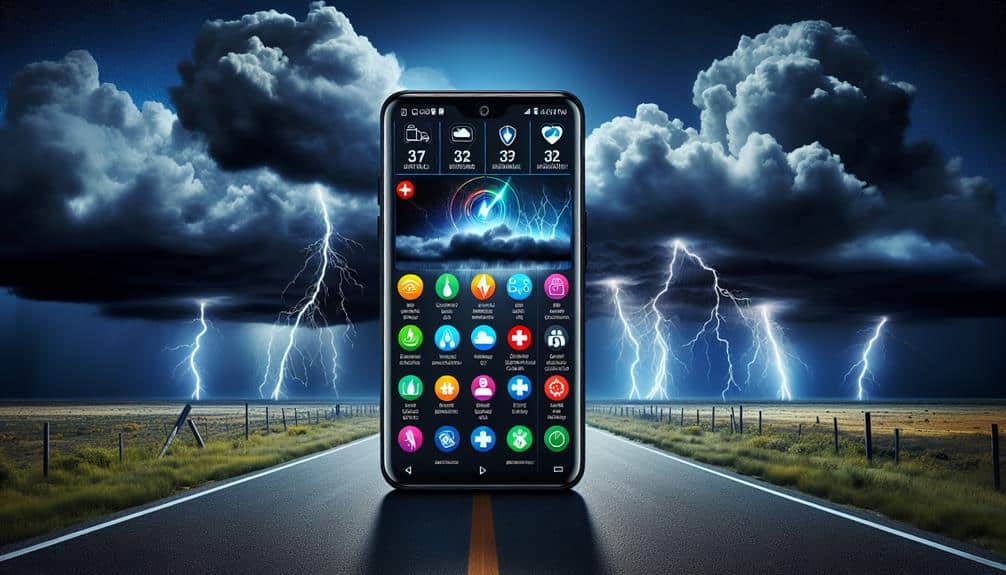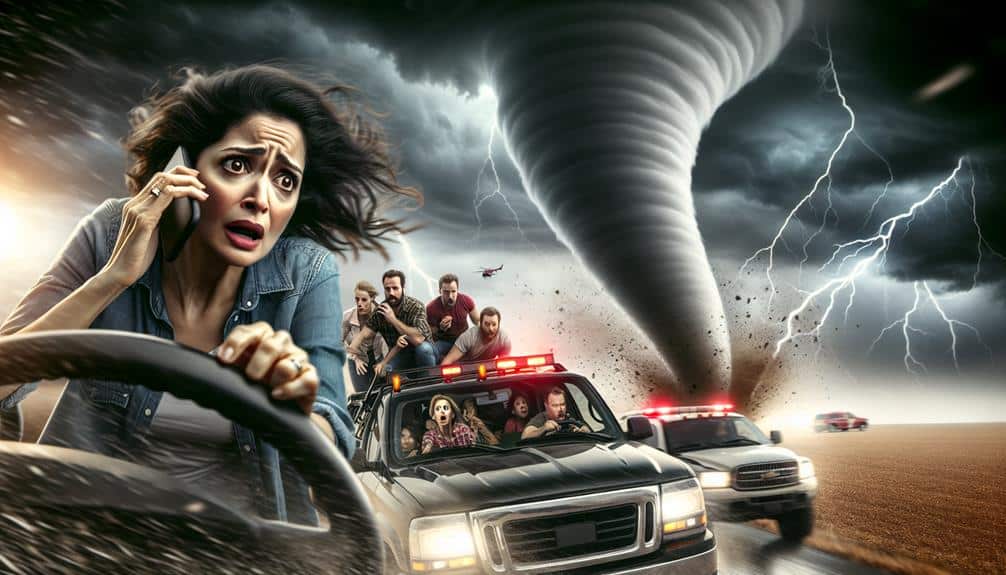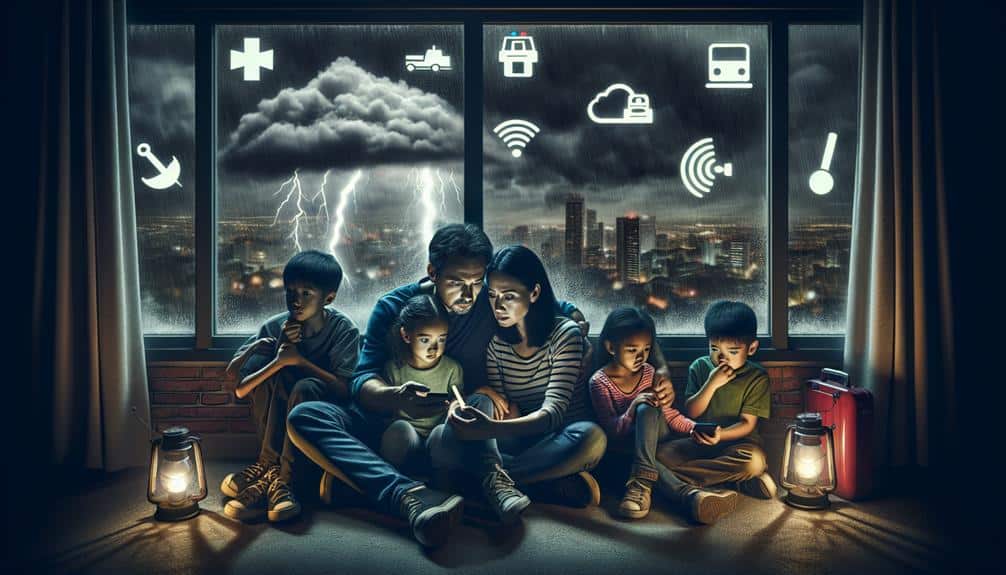We improve emergency readiness for storm spotters using a combination of robust communication methods. VHF and UHF radios guarantee low-latency transmissions across urban and rural areas. Mobile phone alerts, including texts and push notifications, offer real-time updates. Satellite phones provide critical connectivity in remote regions, while two-way radios remain reliable during network failures. Social media and emergency apps disseminate timely information, and online reporting tools facilitate data sharing with precision. This multi-layered approach guarantees extensive coverage, enhancing our ability to respond effectively. Discover more about these integrated notification systems and their benefits in our detailed analysis.
Key Points
- Utilize mobile phone alerts for immediate warnings and real-time updates through text messages, push notifications, and emergency calls.
- Leverage radio communication on VHF and UHF frequencies for low-latency, reliable broadcasts that penetrate atmospheric disturbances.
- Employ satellite phones in remote areas for robust signal strength and timely communication, equipped with GPS tracking and SOS buttons.
- Use social media updates and emergency apps for real-time information dissemination, storm tracking, and interactive maps.
Radio Communication
In radio communication, we rely on VHF and UHF frequencies to transmit real-time weather updates to storm spotters. These radio frequencies provide robust and reliable channels for disseminating important information during severe weather events.
By operating within the VHF (30-300 MHz) and UHF (300 MHz-3 GHz) bands, we can guarantee that our emergency broadcasts penetrate through atmospheric disturbances, reaching spotters in remote or rugged terrains.
Utilizing these frequencies, we achieve low latency in our transmissions, which is essential when every second counts. Our data shows that VHF is particularly effective in rural areas with fewer obstructions, while UHF excels in urban settings with dense infrastructure.
This dual-frequency approach gives us the flexibility to adapt to various environments, enhancing the overall reliability of our communication network.
Moreover, our emergency broadcasts are designed to be concise yet detailed, providing real-time updates on storm trajectories, wind speeds, and potential hazards. This method allows storm spotters to make informed decisions quickly, ensuring their safety and that of the communities they serve.
Mobile Phone Alerts
Mobile phone alerts play a vital role in our emergency notification system, delivering timely and precise weather warnings directly to storm spotters' devices. These alerts enhance our ability to respond quickly, leveraging the widespread adoption and connectivity of mobile technology. By integrating multiple alert mechanisms, we ensure thorough coverage and redundancy.
There are several methods we employ to maximize the effectiveness of mobile phone alerts:
- Text message alerts: These provide concise, immediate warnings that can be received even in areas with limited data connectivity.
- Emergency calls: Automated voice messages guarantee critical information reaches spotters who may not be able to read texts or notifications while in the field.
- Push notifications: Enabled through specialized weather apps, these notifications offer real-time updates and can include detailed information such as storm paths and intensity.
- Weather apps: These apps provide an additional layer of detail and context, allowing spotters to access radar images, forecasts, and historical data.
Satellite Phones
While mobile phone alerts are effective, satellite phones offer an essential communication method for storm spotters operating in remote areas where cellular networks may fail. Satellite phones maintain robust signal strength even in the most isolated locations, ensuring that we stay connected during critical situations. This capability is crucial for immediate and reliable communication with emergency contact teams when storm conditions rapidly deteriorate.
By bypassing terrestrial infrastructure, satellite phones mitigate the risk of communication blackouts, a common issue during severe weather events. They operate on a network of geostationary or low Earth orbit satellites, providing coverage across vast geographic areas. For storm spotters, this means a consistent and dependable link to support services, regardless of location.
Moreover, satellite phones are equipped with features tailored for emergency use, such as GPS tracking and dedicated SOS buttons. These functionalities enable us to send precise location data and distress signals, facilitating prompt rescue operations. Data from various storm tracking agencies confirms that timely and accurate communication can significantly decrease response times and enhance safety outcomes.
Social Media Updates
Social media platforms serve as real-time information hubs that allow storm spotters to disseminate updates quickly to a broad audience. Leveraging these platforms for crisis communication ensures that critical information reaches individuals when they need it most. Our ability to deliver real-time updates can have a significant impact on community engagement and enhance information sharing.
To maximize the effectiveness of social media during storm events, we should focus on the following strategies:
- Automated Alerts: Use tools that enable us to schedule and automate important updates, ensuring timely and consistent communication.
- Multimedia Content: Incorporate images, videos, and infographics that visually convey the severity and specifics of the storm, aiding in better understanding.
- Hashtags and Keywords: Utilize relevant hashtags and keywords to enhance discoverability and reach a broader audience, facilitating faster dissemination of essential information.
- Interactive Engagement: Encourage community engagement by responding to queries, providing real-time updates, and sharing user-generated content that adds value to the information pool.
Emergency Apps

Emergency apps offer storm spotters with versatile tools for delivering timely, data-rich notifications directly to users' mobile devices. Leveraging advanced communication technology, these apps enhance emergency preparedness by providing real-time storm tracking, location-based alerts, and interactive maps. They empower us to disseminate critical information quickly and efficiently, making certain that users receive pertinent updates regardless of their location.
Utilizing data from multiple sources, such as radar feeds and satellite imagery, emergency apps synthesize complex meteorological data into user-friendly formats. This allows us to convey detailed information about storm severity, projected paths, and safety recommendations. The integration of push notifications ensures immediate attention, while customizable settings enable users to personalize alerts based on their specific needs and preferences.
Moreover, these apps often incorporate features like emergency contact lists and resource directories, further strengthening community resilience. By facilitating two-way communication, they enable users to report real-time conditions, thereby enhancing situational awareness and collaborative response efforts.
Two-Way Radios
Two-way radios remain a vital tool for storm spotters, providing reliable, real-time communication in areas where cellular networks may fail. Given the unpredictable nature of severe weather, having a dependable device is essential.
Our analysis highlights several key metrics for evaluating two-way radios:
- Signal Strength: In volatile weather conditions, strong signal strength is paramount. Radios with excellent signal strength can transmit and receive clear messages even in heavy rain or dense cloud cover.
- Battery Life: Extended battery life ensures that radios remain operational throughout prolonged storm tracking activities. We recommend models with rechargeable batteries that offer a minimum of 12 hours of continuous use.
- Communication Range: The effective communication range of a two-way radio can vary significantly. For storm spotters, a range of at least 25 miles is ideal to guarantee coordination over large geographic areas.
- Weather Resistance: Radios must be durable and weather-resistant to withstand harsh conditions. Look for devices rated IP67 or higher, indicating they're dust-tight and can be submerged in water up to 1 meter deep for 30 minutes.
Online Reporting Tools
While two-way radios are essential for real-time communication, online reporting tools offer storm spotters a robust platform for logging and sharing detailed observations with meteorological agencies and fellow spotters. These digital platforms enhance community engagement by allowing us to upload photos, videos, and detailed weather data in real-time. By leveraging these tools, we can streamline the reporting process, ensuring our observations are accessible to a broader audience.
Online reporting tools enhance data accuracy. With built-in geolocation features, our reports are tagged with precise coordinates, reducing the margin for error. Moreover, most platforms offer standardized forms for data entry, which minimizes inconsistencies and enhances the reliability of the information we provide. This is vital for meteorological agencies that rely on our data for forecasting and issuing warnings.
Community engagement is another significant benefit. Through these platforms, we can interact with other spotters, share insights, and stay updated on emerging weather patterns. This collaborative environment fosters a sense of camaraderie and collective responsibility, empowering us to make informed decisions quickly. By integrating online reporting tools into our storm-spotting activities, we not only improve data accuracy but also strengthen our community's overall effectiveness.
Frequently Asked Questions
How Can Storm Spotters Effectively Coordinate With Local Emergency Services?
Did you know 70% of emergency response times improve with efficient coordination? We can boost these stats by adopting robust communication strategies, ensuring storm spotters relay accurate data swiftly to local emergency services for rapid action.
What Training Is Recommended for New Storm Spotters?
For new storm spotters, we recommend comprehensive training through online courses and workshops. Additionally, gaining field experience and participating in drills is essential. This multi-faceted approach guarantees preparedness and enhances our ability to respond independently.
How Can Storm Spotters Ensure the Accuracy of Their Reports?
To guarantee the accuracy of our reports, we must rigorously apply data verification techniques and adhere strictly to established communication protocols. This approach assures our observations are reliable, empowering us with the freedom to make informed decisions.
What Are the Best Practices for Storm Spotter Safety in Severe Weather?
Let's put on our thinking caps. For storm spotter safety, we should follow strict safety protocols, and effective communication strategies. Conduct thorough risk assessments and develop clear response plans to minimize exposure and guarantee timely, coordinated actions.
How Can Storm Spotters Contribute to Community Preparedness Efforts?
We can enhance community engagement and preparedness efforts by providing accurate, timely reports. Our real-time data boosts public awareness and aids disaster response, empowering communities to act decisively and maintain their freedom during severe weather events.


